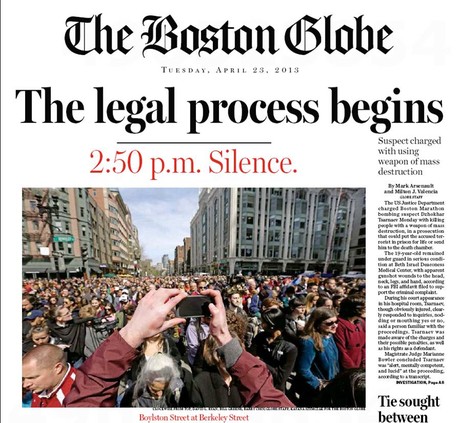Boston Globe Masters Social Media in a Crisis
How the Boston Globe Covered the Boston Marathon Bombing
What does it take to beat all the major news and cable networks in news coverage? An amazing team and a commitment to getting it right! The Boston Globe took the time to fact check every piece of information, yet keep up-to-the-minute with a continuing real-time blogging. And it opened up all its paid online services to everyone for free information all week. As a result, the Boston Globe became the trusted source of information during the Boston Marathon crisis.
NETTING IT OUT
During the dreadful week of April 15th, 2013, the eyes of the world were riveted on Boston. You would expect the local press—newspapers, TV, radio—to be in the midst of the fray, doing their best to stay on top of the evolving story. But what the staff of the Boston Globe actually did was exceptional by any measure. They beat all the major news and cable networks in news coverage, not just because they were local, but because 1) they were careful to fact check everything, 2) they had a proven process for covering news in real time using social media, and 3) they were good at improvising.
© 2013 Boston Globe
The Boston Globe did a stellar job of covering the Boston Marathon bombing and its aftermath.
HOW DID THE BOSTON GLOBE STAY ON TOP OF EVENTS AND (MOSTLY) AVOID MIS-REPORTING?
The Challenge: Following Real-Time Breaking News in a Chaotic Crisis
At 3:30 pm on Monday, May 15th 2013, I received an email from my Boston-based son: “We’re fine. I was working at home today.” That was my first clue that something big had happened. I turned on the news and learned about the Boston Marathon bombing. As I watched the horrifying news from afar (Maine, not Boston), after checking in with local family, colleagues, and friends, I did what most of us did last week: I kept monitoring the Internet for up-to-the minute information. Unlike many, I avoided turning on the TV, except a couple times a day, because I knew that I would wind up emotionally hooked in and riveted to the constantly repeating recaps on all the news channels.
I tried following the news on Twitter, but found it bewildering. Nevertheless, it was the retweeting of news snippets from the Boston Globe that took me to the Globe’s Boston.com live blog. Then I breathed a sigh of relief. I had found a real-time source of information that was full of news, devoid of sensationalism, and clearly following events in real time. This site remained my trusted source all week.
After the dust had settled, with one alleged perpetrator dead and the second one captured and confessing from his hospital bed, I began to reflect on the week’s news coverage. I was intrigued by the many ways that citizen journalism and crowdsourcing sprang into action to submit photos and videos and to pour through and analyze them to try to identify the villains. But, at the same time, I was troubled by the vigilantism and the false accusations that were no doubt made about innocent bystanders. People were trying to be helpful, but it appeared that their adrenaline was taking over.
There were many heroic efforts to follow events in real time, including many people who tweeted round the clock. One of them was Michael Skolnik. He covered the manhunt in 350 tweets over 24 hours from the shooting of MIT patrol officer, Sean Collier, to the capture and death of Tamerlan Tsarnaev, the older brother, through to the hunting down and capture of the second alleged perpetrator, Dzhokhar Tsarnaev. Michael tweeted nonstop and went without sleep for over 24 hours as the story unfolded. I suspect that many others did too. You can see all his tweets here, on Storify...
(Download the PDF for the entire article.)
Sign in to download the full article
0 comments
Be the first one to comment.




